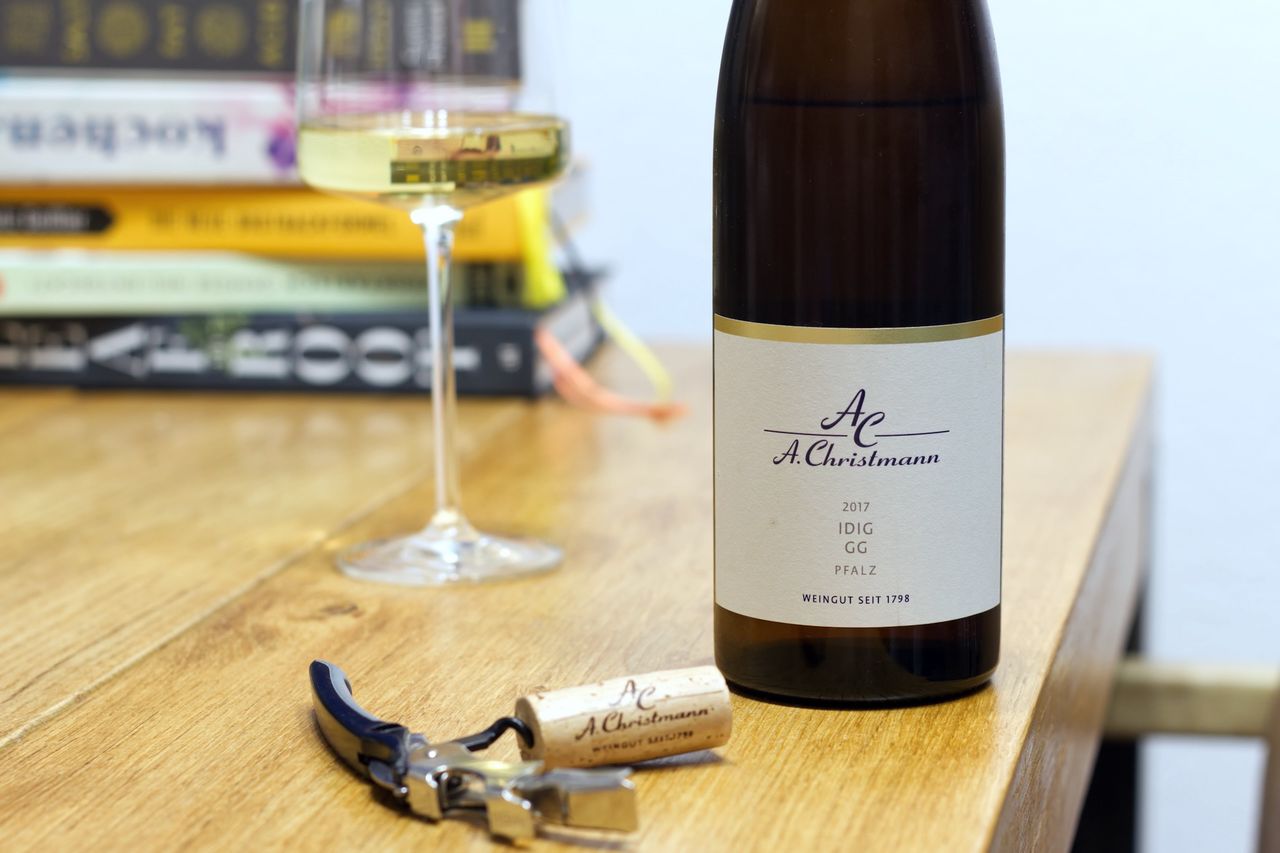Christmann - Idig 2017
We're having a bottle of 2017 Riesling from Weingut Christmann's Königsbacher Idig vineyard.

There was a time when essentially every bottle of wine I opened was Riesling. That is no longer the case, not at all in fact. And when I do reach for Riesling now, it’s almost always sparkling wine or Kabinett. But sometimes the desire for Riesling overtakes me, and neither sparkling wine nor Kabinett is enough. This time, a bottle of Idig 2017 from Weingut Christmann must do the job. I must admit that I’ve lost track a bit by now, but it could be that this is the first wine to make a double appearance in this blog. The last time, over four years ago, it wasn’t alone, and the vintage, also with a four-year difference, was different as well. Today, this one wine receives all the attention. For both vintages, there were corresponding estate wines in the VDP quality pyramid. That has also changed. With the 2022 vintage, Sophie and Steffen Christmann have focused or streamlined their assortment, depending on one’s perspective. There are now only wines from classified vineyards, and consequently, a vineyard blend has taken the place as the entry-level wine. Additionally, there are only Weissburgunder, Riesling, and Spätburgunder left. The idea behind it is somewhat understandable, because I guess the most differentiation happens within premium wines and not in the base. However, this is the winery of VDP President Steffen Christmann and it now has essentially eliminated the lower two levels of the association’s pyramid. I’m curious to see if this example will be followed. At the same time, this means that a bit more spotlight falls on each individual wine, like this Riesling from the Königsbacher Idig. The grapes, grown on limestone, were handpicked and then spontaneously fermented. The aging took place in large wooden barrels.
The Idig needs a few years. We tried this exact wine at a fair about four years ago and decided to forget that we owned this bottle for a while. You often read here and there that a Großes Gewächs should be given at least five years. Some pretty amazing and significantly younger bottles from recent years would contradict that, but as a rule of thumb, it might not be so bad. Because nothing really seems mature here yet. There’s smoke on the nose and a slightly creamy but still very firm yellow fruit and fresh grapes. The impression oscillates between matured and young, but no matter how you decide, it’s quite intense and dense when smelling. And the fruit also makes it to the palate. There’s also a lot of freshness, and the wine still feels significantly younger here. Where you might have been sure while smelling that a few years have passed, this impression blurs while drinking. And this is not due to the alcohol. I was disappointed at how quickly the wine’s taste disappears with the first sip, but then each subsequent sip builds on it, staying longer and longer, so that the mouthfeel somehow accumulates more and more, and by the end of the first glass, it doesn’t want to disappear at all. I’ve never experienced that before. And the juiciness is quite similar. It’s pretty powerful. And also, the fact that the empty glass is good for more than just pouring again is always a good sign. In the empty glass there’s much more fruit, sweetness, and creaminess and less smoke. And then it’s time for a refill.
Overnight, the wine seems to realize that it has already spent some time in the bottle. It smells more mature, yellow, and the smoke is gone. I wanted to write briefly that it has become broader, but that’s not the right word. It has become more, though. There is acidity, but if you like to remove tooth enamel, you’re in the wrong place. The Idig lives more on the texture than from the acidity. And even when drinking, it appears more mature. There’s more fruit, more creaminess, ripe mango, citrus, and herbs. Wait, I need to fill up again briefly. This is dense, complex, salty, and structured, and yet soft and supple. Now the first sip lingers on the palate for a long time, and it’s hard for me to say whether I prefer this second evening or the first, and because that’s exactly what makes it so exciting, a small remainder may stay in the refrigerator for another night.
And then not much changes. The nose continues to be herbal, slightly mature and yellow, with an open bottle of glue somewhere in the room. What had developed towards creaminess in taste takes a step back and regains the pull of the first evening. This is not a loud wine. It wasn’t in 2013 either. But it’s an intense wine, balanced, calm, and round. And with all the loudly shouting impressions and wines in the world, it’s often difficult to distinguish precisely this calmness from boredom and recognize it for what it is. Greatness. I’m sure that despite its 6 years of age, the wine is still at the very beginning. But to say where it’s going, I still lack the experience. Someday I might get there too. But anyone opening the bottle now will certainly not be disappointed.